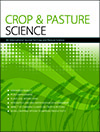Soil tests are the basis of fertiliser decisions. Much of the phosphorus (P) fertiliser applied to wheat crops on alkaline soils is not immediately available and becomes locked up in soil. Sowing crops early in April improved the use of soil P and reduced the crop’s dependence on fertiliser P even when soil tests indicated that the crops would be responsive. The results suggest that interpretation of soil tests may need to be modified with early sowing.

Crop and Pasture Science
Volume 72 Number 11 2021
CP21118Genetic interaction and inheritance of important traits in durum (Triticum turgidum ssp. durum)×emmer (Triticum turgidum ssp. dicoccum) crosses under two water regimes
 , Mohammad Mahdi Majidi
, Mohammad Mahdi Majidi  , Mohsen Esmaeilzadeh Moghaddam, Farzaneh Rabbani and Fatemeh Noori
, Mohsen Esmaeilzadeh Moghaddam, Farzaneh Rabbani and Fatemeh Noori
Pasta is mainly produced from durum wheat (Triticum turgidum ssp. durum, which is different from bread wheat (Triticum aestivum L.). To make durum wheat grow and yield in water limited regions of the world, drought tolerant genes may be transferred from a relative species emmer wheat (Triticum turgidum ssp. dicoccum). This research was conducted to make this achievable by understanding how well the gens between the two species combine and express themselves.
Genetic analysis of seed yield is important in the breeding of high-yielding cultivars in soybean. The aim of this study was to develop high-yielding lines by using marker-assisted selection for seed yield and lodging tolerance. We developed six pyramiding lines with favourable alleles at seven QTLs associated with seed yield and one QTL associated with lodging tolerance and the seed yields of them tended to be greater than those of their parental cultivars.
CP21316Effects of gypsum on growth and nutrient status of forage grasses cultivated between the rows of organically grown Satsuma mandarin in an Oxisol from subtropical Brazil
 , Renato Vasconcelos Botelho, Marcelo Marques Lopes Muller, Poliana Horst Petranski, Eduardo Luiz Costa Tobias Pinto, Talia Aksenen, Sidnei Osmar Jadoski and Leandro Rampim
, Renato Vasconcelos Botelho, Marcelo Marques Lopes Muller, Poliana Horst Petranski, Eduardo Luiz Costa Tobias Pinto, Talia Aksenen, Sidnei Osmar Jadoski and Leandro Rampim
Setaria grass and black oat are forage grasses tolerant of soils with low natural fertility. We studied the effect of agricultural gypsum in a low fertility soil on soil fertility properties, growth and plant nutrition of Satsuma mandarin, and plant biomass yield and soil nutrient extraction by setaria grass and black oat in the absence of soluble industrial fertilisers. These forage grasses may be used as inter-row cover crops for organic orchards of Satsuma mandarin, which present restrictions on the use of soluble industrial fertilisers.
Perennial forage plants persist in the field indefinitely, so the growth during establishment is important to determine the whole lifecycle. Here, we studied how fast the root elongated downward among different grasses of the same species, and found root activity and shoot growth could affect the root elongation rate. Our finding implied that the selection for grasses with specific traits can improve the forage establishment over a shorter time.
Fourteen white clover cultivars and 42 experimental synthetics were evaluated for seasonal growth under beef cattle, dairy cattle and sheep grazing across 4 years. Entries with specific and broad adaptation to the three grazing management types were identified. Cv. Legacy was more responsive to cattle and dairy grazing, and cv. Quartz to sheep grazing. Synthetics with specific and highly above-average performance across all three grazing managements, superior to the cultivars, were identified.
CP21084 Abstract | CP21084 Full Text | CP21084PDF (1.8 MB) Open Access Article
The native budworm (Helicoverpa punctigera) is an important economic polyphagous insect pest and widely distributed in Australia; however, there are few records of its occurrence on plants with the C4 photosynthetic pathway. We assessed the capacity of H. punctigera to oviposit on saltbushes (a group of C4 plants) to establish their potential as hosts. Our findings suggest that saltbushes can support populations of H. punctigera, indicating its potential as a pest of saltbushes.
CP21123Grazing strategies for resilience of ryegrass (Lolium perenne) dominant pastures in hill country
We investigated the impacts of deferred grazing (livestock excluded from mid-spring to late summer to enable perennial ryegrass to flower and set seed), early opening (livestock excluded from mid-spring to early summer to enable perennial ryegrass to flower) and standard rotational grazing on hill country pastures and soils under beef and sheep grazing. Compared with standard rotational grazing, deferred grazing had positive effects on pasture productivity but only short-term effects on soil quality, whereas early opening had few effects on the pastures or soils.



